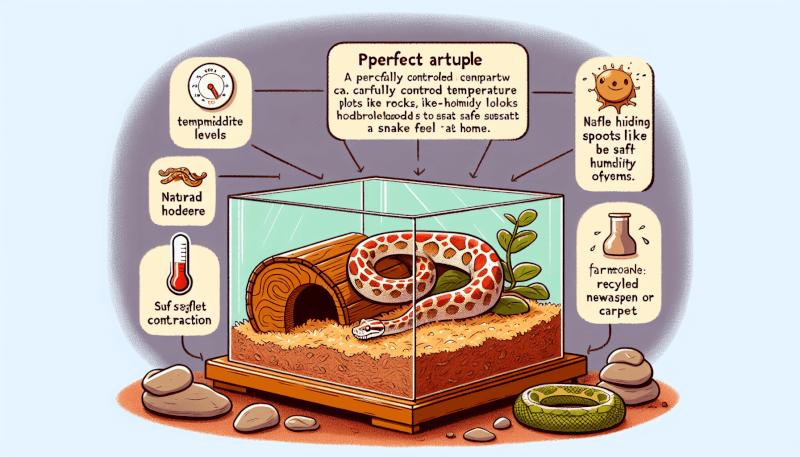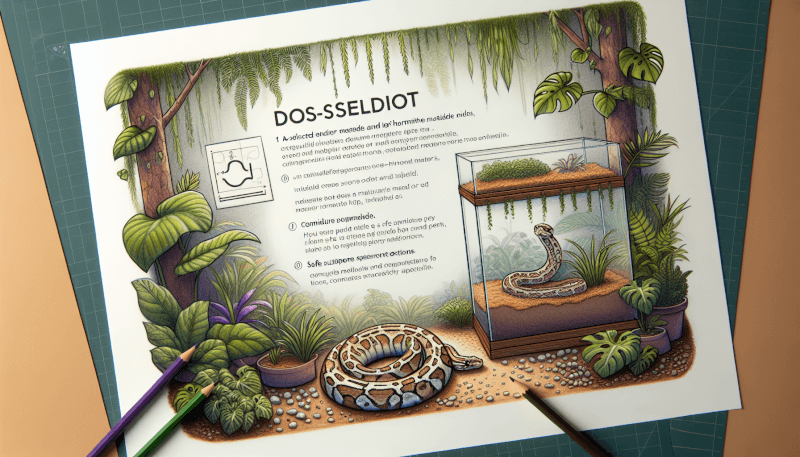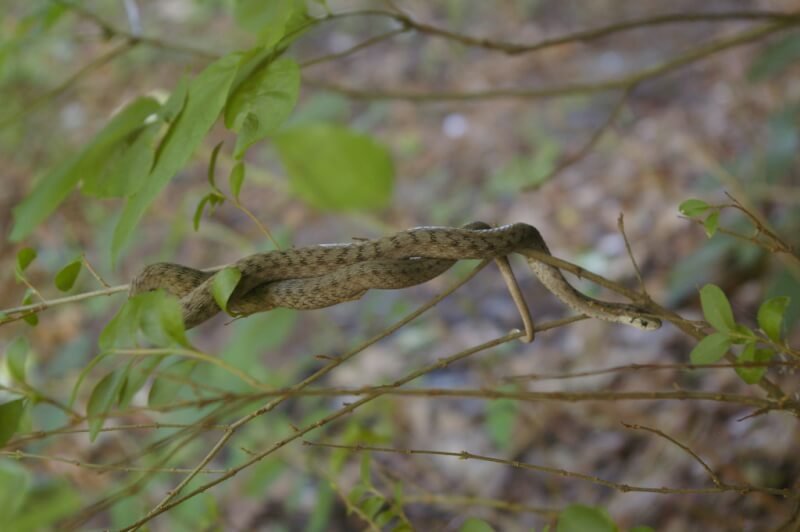Owning a pet snake can be a fascinating and rewarding experience, but it is important to ensure that your scaly friend feels safe and stress-free in its habitat. Creating a stress-free environment for your pet snake is crucial for its overall well-being and happiness. From providing the right temperature and humidity levels to mimicking its natural habitat, there are several simple steps you can take to ensure your pet snake feels relaxed and content in its surroundings. By following these tips, you can create a tranquil home for your pet snake, allowing it to thrive and enjoy its life to the fullest.

Choosing the Right Enclosure
Size of the enclosure
When it comes to choosing the right enclosure for your pet snake, size is an essential factor to consider. Snakes need enough space to move around and explore, as confinement in a small enclosure can lead to stress and discomfort. It is recommended to provide an enclosure that is at least as long as your snake’s length, allowing them to stretch out fully. Remember that snakes can grow, so it’s important to choose an enclosure that can accommodate their eventual size.
Adequate ventilation
Proper ventilation is crucial for maintaining a stress-free environment for your pet snake. Without adequate airflow, the enclosure can become stagnant and lead to respiratory problems. Ensure that the enclosure has vents or mesh-covered sides to allow fresh air to circulate. However, be cautious not to provide too much ventilation, as this can result in temperature and humidity fluctuations.
Temperature and humidity control
Snakes are ectothermic creatures, meaning they rely on their environment for temperature regulation. It is essential to provide appropriate temperature and humidity levels in their enclosure to keep them healthy and stress-free. Research your snake’s specific temperature and humidity requirements and invest in a reliable thermostat and hygrometer to monitor and regulate these factors accurately. Maintaining a consistent and comfortable environment will help your snake thrive.
Creating a Comfortable Habitat
Substrate
Choosing the right substrate for your pet snake’s enclosure is vital for their comfort and well-being. The substrate should mimic their natural habitat while being easy to clean and maintain. Options such as aspen shavings, cypress mulch, or reptile carpet can provide a suitable substrate for most snake species. Avoid substrates that may be ingested or cause impaction, such as sand. Regularly spot cleaning and replacing the substrate will help maintain a clean and stress-free environment.
Hiding spots
Snakes are known for their secretive nature, and providing adequate hiding spots within their enclosure is essential. Hiding spots allow snakes to retreat when they feel threatened or stressed, promoting a sense of security. Place multiple hiding spots throughout the enclosure, using various sizes of caves or reptile hides. Ensure that the hiding spots are secure and will not collapse or cause injury. Having multiple hiding options will give your snake the freedom to choose their preferred spot.
Climbing opportunities
Many snake species enjoy climbing and exploring their environment. Adding climbing opportunities to their enclosure can provide both physical exercise and mental stimulation. Branches, logs, or reptile-safe climbing structures can be incorporated into the enclosure to create vertical and horizontal climbing surfaces. Ensure that any additions are securely anchored and won’t fall on the snake. By introducing climbing opportunities, you can create a more enriching and stress-free habitat for your pet snake.
Maintaining Proper Lighting
Natural sunlight exposure
While some reptiles benefit from natural sunlight exposure, it’s important to approach it with caution. Direct sunlight can quickly overheat an enclosure, causing stress and harm to your snake. If you choose to provide natural sunlight, ensure you have a shaded area within the enclosure where your snake can retreat. Additionally, monitor the temperature regularly to prevent overheating. It’s essential to strike a balance between the benefits of natural sunlight and the potential risks it poses.
UVB lighting
UVB lighting plays a crucial role in reptile health, as it helps them produce vitamin D3, which is essential for calcium absorption. Choose a reputable UVB light specifically designed for reptiles and follow the manufacturer’s instructions for placement and duration. Place the UVB light in a way that your snake can bask within its range, but avoid direct exposure to the light for extended periods, as this can cause stress or eye damage. UVB lighting should be part of a larger lighting system that also provides heat and visible light.
Lighting schedule
Establishing a consistent lighting schedule is important for regulating your snake’s circadian rhythm and providing a sense of routine. Snakes generally require 10-12 hours of light and 12-14 hours of darkness per day. To mimic their natural environment, it’s best to set up a timer for the lighting system that aligns with the natural light/dark cycle of your location. Maintaining a regular lighting schedule will help your snake feel secure and in sync with its surroundings.
Establishing a Consistent Feeding Routine
Choosing the right food
Selecting the right food for your pet snake is essential for their overall health and well-being. Different snake species have specific dietary requirements, so research and understand their natural diet. Most snakes are carnivorous and eat prey such as mice, rats, or small birds. Choose high-quality, properly-sized prey that meets your snake’s nutritional needs. It is recommended to feed frozen and thawed prey to reduce the risk of injury to your snake and prevent the introduction of parasites or diseases.
Feeding frequency and portions
Establishing a regular feeding schedule is important for your snake’s overall health. Younger snakes typically require more frequent feedings, while adults may eat less often. Research your specific snake species to determine the appropriate feeding frequency. Offer prey that is appropriately sized, roughly the same diameter as the thickest part of your snake’s body. Overfeeding can lead to obesity and other health issues, while underfeeding can result in malnutrition. Finding the right balance is key to maintaining your snake’s health and preventing stress.
Feeding method
When it comes to feeding your pet snake, there are various methods to consider. The most common methods include using tongs or forceps, leaving the prey item in the enclosure, or assisted feeding. The best method depends on your snake’s temperament and feeding response. Using tongs or forceps is generally recommended to minimize any risk of being mistaken for prey. When offering food, be patient and observe your snake’s feeding behavior to ensure they are consuming the prey item safely. Maintaining a calm environment during feeding will help reduce stress for your snake.
Providing Clean Water
Fresh and accessible water source
A clean and easily accessible water source is vital for your pet snake’s well-being. Snakes, like all animals, require hydration to thrive. Provide a shallow water dish that is large enough for your snake to submerge in comfortably. Check the water dish daily, refreshing it with clean water as needed. Avoid using deep water dishes that may pose a drowning risk. Additionally, monitor the humidity levels in the enclosure to prevent the water from evaporating too quickly, ensuring a consistent water source for your snake.
Regular water changes
Regularly changing the water in your snake’s dish is crucial for maintaining cleanliness and preventing the growth of bacteria or other pathogens. Replace the water at least once a day or as soon as it becomes soiled. Snakes may defecate or shed in their water dish, making it necessary to clean and refill it promptly. By providing fresh and clean water, you create a more comfortable and stress-free environment for your pet snake.
Choosing the right water dish
The choice of water dish for your pet snake should take into consideration their size and behavior. Use a dish that is heavy and stable to prevent it from tipping over easily. For smaller snakes, a shallow dish will suffice, while larger snakes may require a deeper dish to accommodate their size. Choose a dish made of smooth material that is easy to clean and free of sharp edges that could potentially harm your snake. Providing the right water dish will ensure that your snake can access and drink water without any difficulty.
Handling and Interaction
Importance of proper handling
Handling your pet snake correctly is crucial to prevent stress or injury to both the snake and yourself. Proper handling techniques can help build trust between you and your snake while minimizing the risk of accidents. Always approach your snake calmly and confidently, supporting their body along its length. Avoid sudden movements or loud noises that could startle or stress the snake. Proper handling can allow for positive interaction and help your snake feel safe and secure in your presence.
Gradual desensitization
For snakes that are more skittish or easily stressed, it may be beneficial to gradually desensitize them to handling. Start with short sessions of gentle handling, gradually increasing the duration as your snake becomes more comfortable and relaxed. Pay attention to your snake’s body language and respond accordingly. If they show signs of distress or resistance, allow them to retreat to their enclosure and try again another time. Gradual desensitization will help your snake associate handling with positive experiences, reducing stress over time.
Avoiding sudden movements or loud noises
Snakes are naturally cautious creatures, and sudden movements or loud noises can startle and stress them. When interacting with your pet snake, it’s important to move slowly and gently. Avoid sudden jerks or rapid motions that could trigger a defensive response. Similarly, keep the environment calm and quiet during handling sessions. Loud noises or sudden disturbances can make your snake feel threatened or unsafe, leading to stress or even aggressive behavior. By maintaining a calm and serene environment, you can create a stress-free atmosphere for your pet snake.

Maintaining a Quiet Environment
Minimizing noise disruptions
Noise disruptions can be incredibly stressful for your pet snake. Try to minimize loud noises or sudden sounds in the vicinity of their enclosure. For example, keep the enclosure away from areas with heavy foot traffic or loud appliances. If there are unavoidable sources of noise, such as construction or household activities, consider using soundproofing techniques, such as placing the enclosure in a quieter room or using sound-dampening materials around it. By reducing noise disruptions, you can provide a more peaceful environment for your snake.
Soundproofing the enclosure
If your snake’s enclosure is located in a particularly noisy area, soundproofing the enclosure can be beneficial in reducing stress. Utilize sound-absorbing materials, such as acoustic panels or carpets, around the enclosure to dampen external noise. Ensure that the materials used are safe for reptiles and do not pose any health risks. Soundproofing can help create a serene atmosphere within the enclosure, allowing your snake to relax and feel more comfortable.
Creating a calm atmosphere
Creating a calm atmosphere within the enclosure can greatly reduce stress for your pet snake. Ensure that the enclosure is located in a peaceful area of your home, away from excessive foot traffic or other disturbances. Limit the use of bright or flashing lights near the enclosure, as this can cause stress or discomfort. Use dimmer lighting to create a more relaxing environment. Avoid excessive handling or disturbances within the enclosure, allowing your snake to have a quiet and secure space to retreat when they need it.
Regulating a Consistent Schedule
Establishing a routine
Snakes thrive on routine and predictability. Establishing a schedule for daily activities, such as feeding, handling, and cleaning, can help reduce stress and make your snake feel more secure. Set specific times for these activities and strive to maintain consistency. Snakes become accustomed to routine and can become stressed if their daily activities are disrupted. By establishing a schedule, you provide a structured environment that your snake can rely on, promoting a sense of security and well-being.
Maintaining regularity in activities
Consistency is key when it comes to maintaining a stress-free environment for your pet snake. Aim to keep feeding, handling, and cleaning activities consistent in terms of time and frequency. Avoid sudden changes, such as switching feeding schedules abruptly or introducing new handling routines without gradual adjustment. Regularity in activities allows your snake to anticipate and adapt to their environment, reducing stress and promoting a more harmonious living environment.
Keeping disturbances to a minimum
To create a stress-free environment for your pet snake, it is important to minimize disturbances as much as possible. Loud noises, excessive handling, or sudden movements can disrupt their sense of security and result in stress. When performing activities within the enclosure or in the vicinity, do so calmly and gently. Avoid unnecessary disturbances, such as rearranging the enclosure or introducing new objects without a gradual transition. By keeping disturbances to a minimum, you provide a more stable and tranquil space for your snake.

Minimizing Stressful Encounters
Limiting exposure to other pets
Introducing pets or other animals to the same space as your pet snake can be stressful for both parties involved. It is crucial to limit exposure to other pets, particularly those with predatory instincts or the potential to harm your snake. Snakes are solitary creatures and prefer to have their own space. Keep other pets away from the snake’s enclosure or create physical barriers to prevent any accidental encounters. By minimizing exposure, you can reduce stress and ensure the safety of your snake.
Avoiding excessive handling during shedding
Shedding is a natural process for snakes, but it can also be a stressful time for them. During shedding, snakes may become more irritable and sensitive to touch. It is important to avoid excessive handling during this time, as it can cause further stress and interfere with the shedding process. Instead, provide a humid hiding spot or a moistened moss box to assist in their shedding. Monitor their progress and only handle them once they have completed the shedding process and regained their usual behavior and comfort.
Creating a peaceful environment during breeding
Breeding can be a stressful and demanding time for snakes. As a pet owner, it is important to provide a peaceful and stress-free environment for your breeding snakes. Separate them from other snakes to avoid unnecessary interactions or territorial disputes. Ensure that the enclosure is spacious enough to accommodate both snakes comfortably. Monitor their behavior closely and intervene if any signs of stress or aggression occur. By creating a tranquil environment, you can promote successful breeding and reduce potential stress-related issues.
Regular Health Check-ups
Choosing a reptile veterinarian
Regular veterinary check-ups are essential for monitoring your pet snake’s health and well-being. Find a reputable reptile veterinarian who is experienced in working with snakes. They will perform routine exams, provide vaccinations if necessary, and address any health concerns promptly. Establishing a relationship with a knowledgeable veterinarian ensures that your snake receives proper medical care, reducing the risk of stress-related illnesses or complications.
Monitoring physical condition
Regularly monitoring your pet snake’s physical condition is crucial for early detection of any health issues. Observe their body condition, appetite, and behavior on a daily basis. Look for any changes in appearance or behavior, such as weight loss, abnormal shedding, or respiratory problems. Regularly check for signs of parasites, such as mites or ticks. By monitoring their physical condition, you can identify potential health issues early and seek appropriate veterinary care.
Recognizing signs of stress or illness
Being able to recognize signs of stress or illness in your pet snake is imperative for their well-being. Common signs of stress include frequent hiding, refusal to eat, aggressive behavior, excessive shedding, or abnormal feces. Symptoms of illness may include lethargy, loss of appetite, respiratory issues, or visible injuries. If you notice any of these signs, contact your reptile veterinarian for advice or to schedule an appointment. Prompt detection and treatment can prevent further stress and promote a speedy recovery.
In conclusion, creating a stress-free environment for your pet snake involves careful consideration of various factors. From choosing the right enclosure size and providing adequate ventilation to establishing a regular routine and reducing disturbances, every aspect plays a crucial role in your snake’s well-being. By prioritizing their physical and mental needs, maintaining cleanliness, and monitoring their health regularly, you can ensure a happy and stress-free life for your beloved snake companion.



